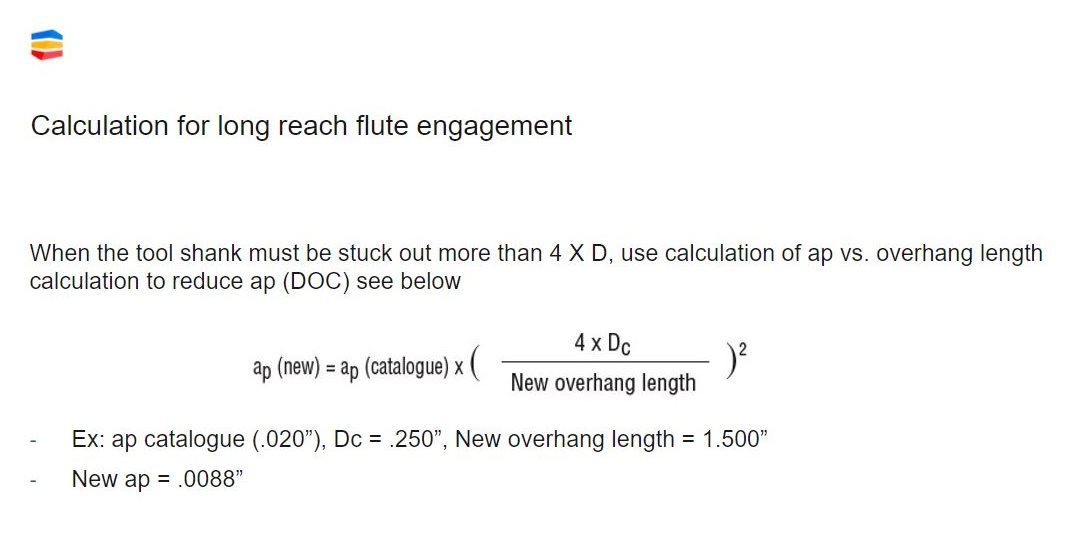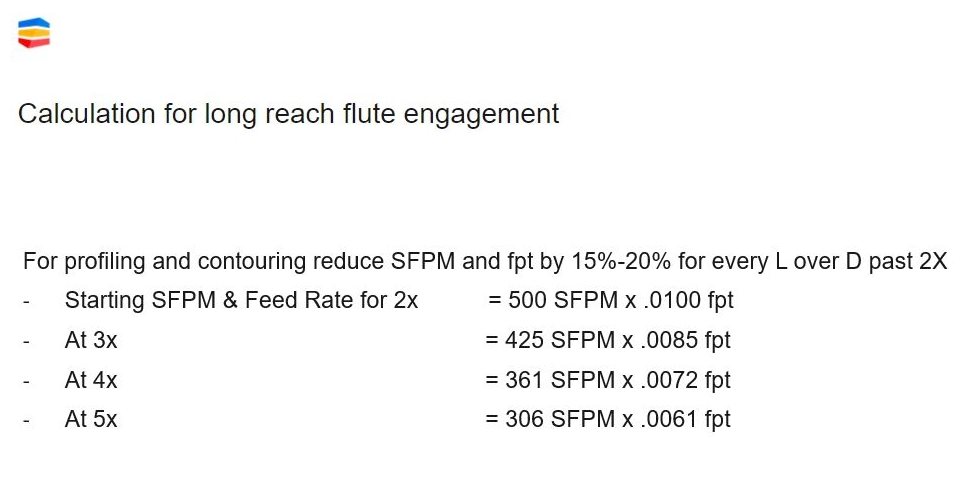Calculating Long-reach Applications & Flute Engagement
Manufacturers continue to be challenged by applications requiring long-reach milling tools in machining applications. Extra-long-reach end mills and extended flute milling and machining tools magnify the dynamic forces at play and must be compensated for. Solid fixturing, rigid tooling and thoughtful tool application are necessary for reliable, accurate long-reach boring, turning and milling.Manufacturers continue to be challenged by applications requiring long-reach end mills or extra-long end mills in machining applications. As engineers combine multiple parts into single designs to eliminate secondary assembly operations, machining requires long-reach milling tools to cut deep cavities and other difficult-to-reach part features. Additionally, the quest for lighter high-performance parts means shops are machining more workpieces from alloys and materials that are increasingly difficult to machine.
In long-reach and extended-tool machining, the cutting edges operate at a considerable distance from the tool holder and its connection to the machine. This can result in unwanted vibration, radial deflection or bending of the tool due to the mechanical loads of machining.
While radial tool deflection affects accuracy and limits cutting depths, tangential deflection pushes the tool downward and away from the workpiece centerline. This reduces the tool’s clearance angle. Vibration in the form of chatter and chip evacuation must also be dealt with when using long-reach milling tools. Extended tooling magnifies the dynamic machining forces at play and must be compensated for in the machining process.
Depending upon severity, the negative impacts of deflection and vibration could include poor surface finishes, loss of precision, rapid tool wear, tool failure and even serious machine tool damage. In all cases, operational economy and sustainability is hindered by downtime, increased repair costs and scrapped parts and tools.
Mastering the rigors of long-reach applications requires a holistic examination of the entire machining system. Machine tool stability, tool holding and tool rigidity, workpiece fixturing, and tool geometry selection all play a role in reducing the harmful effects of deflection and vibration.
From a tooling standpoint, the first and easiest method of addressing the challenges posed by using long-reach milling tools is to ensure the tool and toolholding system is as rigid as possible.
Seco has long been at the forefront of long-reach tooling solutions. To maximize rigidity in extended-tool applications, Seco Steadyline turning and boring bars as well as milling holders allow shops to perform long overhang operations twice as fast as traditional tools. The vibration-damping solutions allow for high metal-removal rates, smooth surface finishes and long tool life while reducing overall stress on the machine tool. Seco also offers specific tooling such as the JS522 high performance end mill that is designed to uniquely counterbalance deflection in difficult machining applications such as those involving forged titanium.
In the end, it all comes down to solid fixturing, rigid tooling and thoughtful tool application for reliable, accurate long-reach boring, turning and milling. In most cases, machining parameters will have to be adjusted to counteract the effects of extended-tool machining applications.
In the latest installments of #SecoTechTalk, Seco Product Manager Jay Ball walks you through two calculations that increase performance and reliability in long-reach applications and flute engagement.
Episode 5 shows you how to save time, headaches, tool wear and surface finishes by understanding how to reduce axial depth of cut in applications where the tool extends from the holder by a distance greater than four times tool diameter.

In Episode 6, Jay explains how to easily calculate surface footage and feed-per-tooth reductions to lessen deflection when engaging a tool with more than two times diameter flute length.

For tips on getting the most from your machining operations, catch more episodes of Jay’s #SecoTechTalk on Seco Instagram. You’ll find practical advice that makes your machining more efficient and sustainable. Leave a comment to let him know what you want to hear about next.
Inline Content - Survey
Current code - 5fce8e61489f3034e74adc64